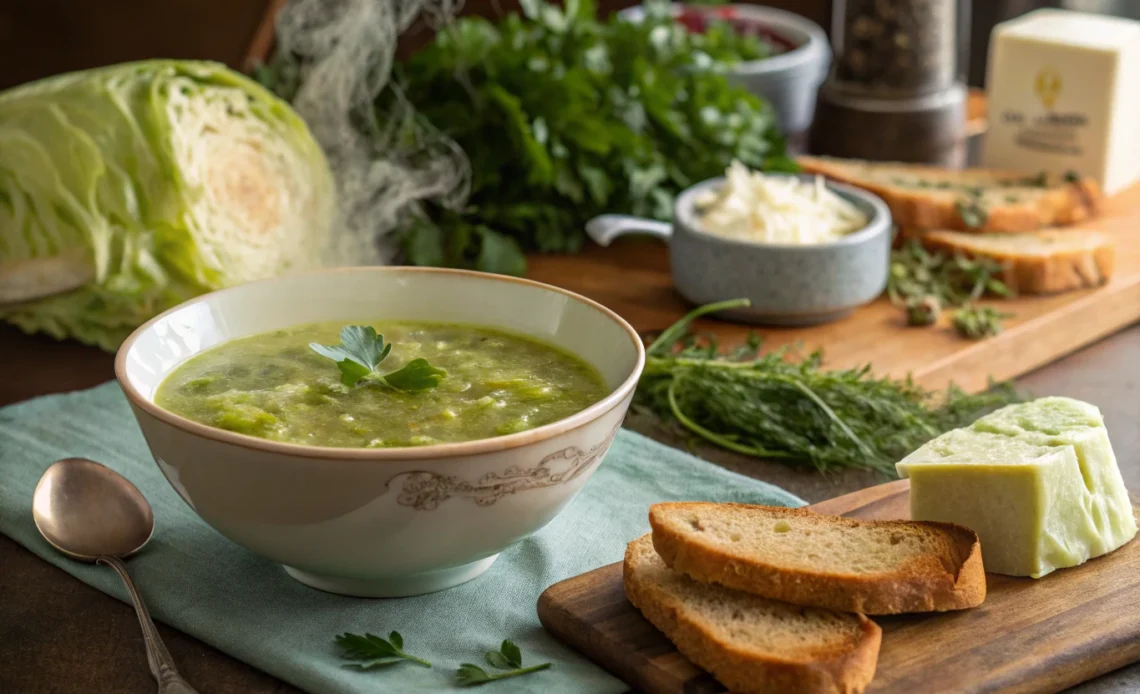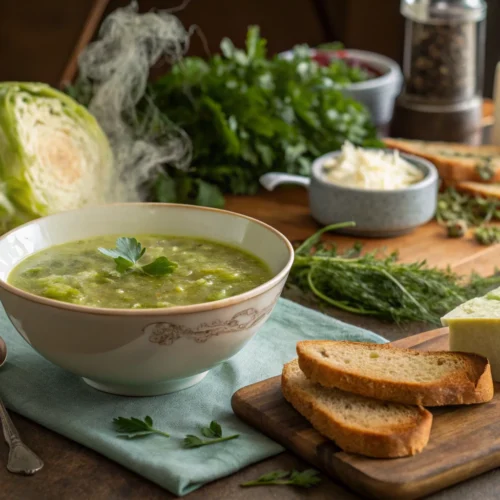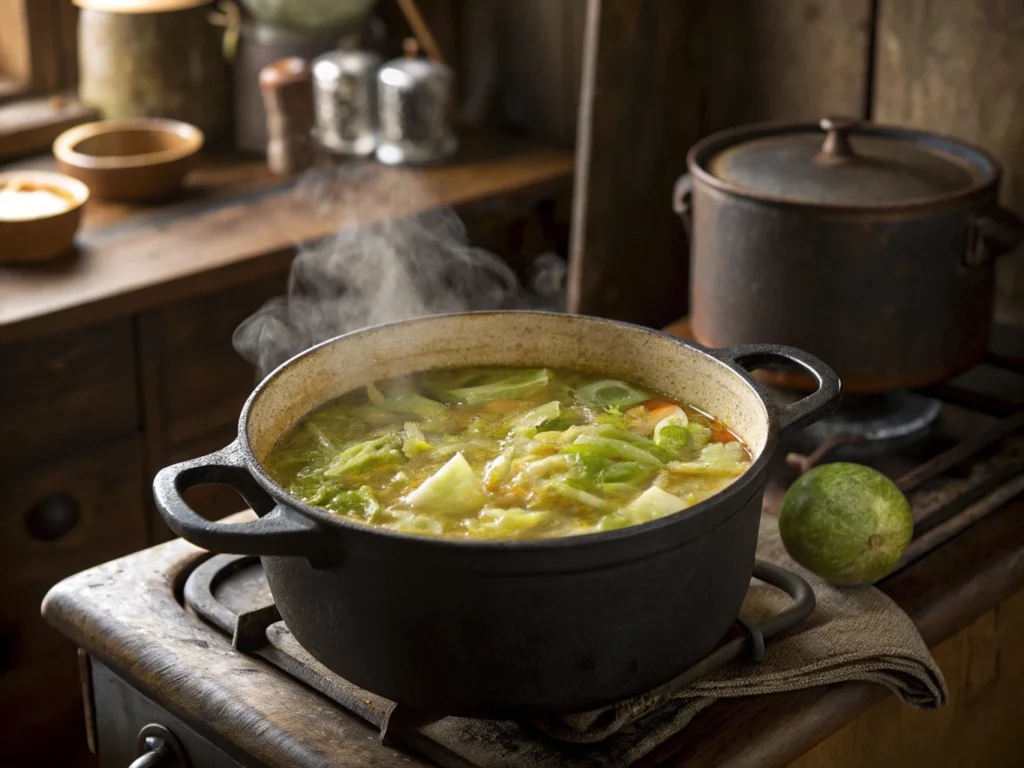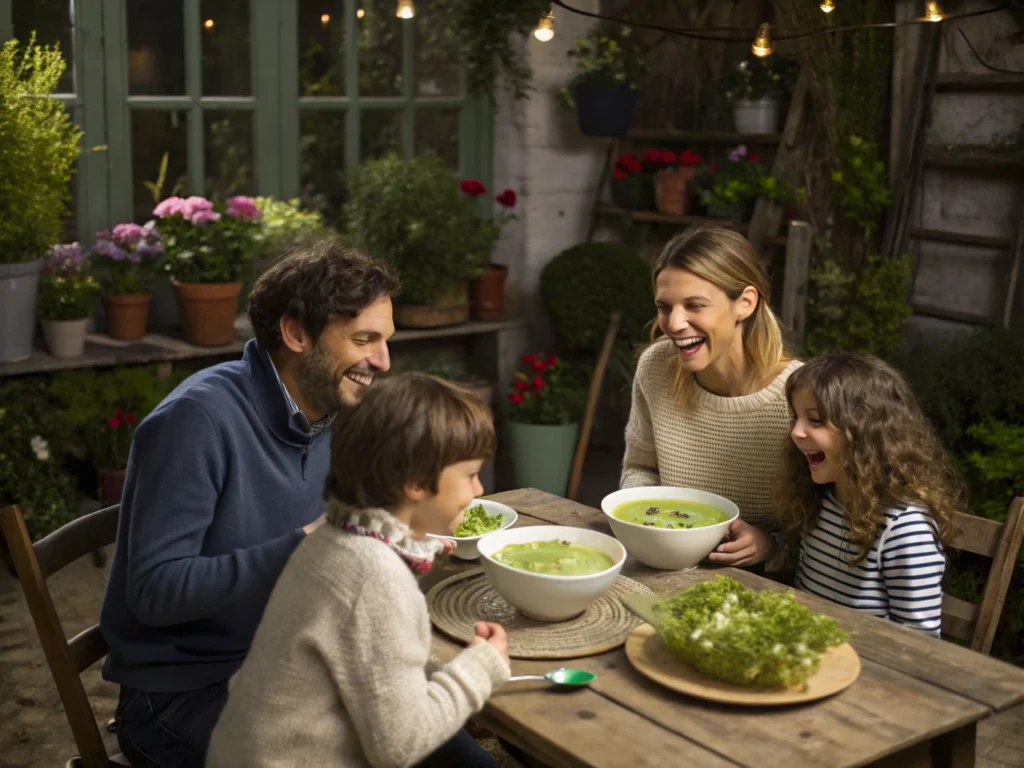
ANNONCE
Table of Contents
ANNONCE

Cabbage Soup
Equipment
- Pot
Ingredients
- 1 small Green cabbage finely shredded
- 3 medium Carrots sliced
- 2 large Potatoes cubed
- 2 Onions finely chopped
- 2 Garlic cloves crushed
- 1.5 L Vegetable broth
- 2 tablespoons Olive oil
- Salt to taste
- Pepper to taste
- Bay leaf to taste
Instructions
- Sauté the onions and garlic in olive oil until translucent.
- Add the carrots and potatoes, and let them sweat for a few minutes.
- Incorporate the green cabbage, then pour in the hot vegetable broth.
- Season with salt, pepper, and bay leaf.
- Cover and simmer gently for 40 minutes.
- Serve hot with a drizzle of olive oil or toasted whole-grain bread.
Notes
🏡 An Ancestral Culinary Tradition
I remember my grandmother, Maria, a woman with a frank gaze and confident gestures. She would prepare cabbage soup every winter Sunday in an enameled pot while we played in the frosty garden. This recipe was more than just a dish; it was a transmission, a link between generations. As soon as the first cold spells appeared, the ritual resumed: Saturday market, choosing the greenest cabbage, the aroma of lard simmering with carrots, potatoes, and onions.
This soup is deeply rooted in the rural traditions of many European regions. In France, Germany, and Poland, cabbage has long been a survival vegetable during the cold months. Inexpensive, nutritious, and easy to store, it was central to peasant diets. Cabbage soup embodied community solidarity: large pots were made and shared among neighbors or members of the same family.
This dish represents more than just a recipe: it bears witness to a popular culinary culture where every ingredient mattered, and time itself was a key component. Even today, bringing this soup back to life reconnects us with a heritage.
ANNONCE

🎮 Cabbage Soup in Popular Culture
Talking about cabbage soup also means evoking its place in popular culture. The film “La Soupe aux Choux,” released in 1981 and starring Louis de Funès and Jean Carmet, immortalized this simple and comforting dish in the French collective imagination. Adapted from René Fallet’s novel, the film uses soup as a metaphor for simplicity, sincere friendship, and the deep bond between humans and the earth.
It is no coincidence that the dish plays a central role: the soup becomes a means of intergalactic communication, a curiosity for the alien visitor. Behind the humor, the film raises a fundamental question: what remains of our roots and our humanity when modernity erases our customs?
Thus, cabbage soup is not just a dish—it is a symbol. A symbol of authenticity, sharing, and collective memory. In my childhood, every spoonful was a return to essentials. Even today, I prepare it thinking of those silent moments of transmission where the heart spoke through simple gestures.
🧬 A Vegetable Rich in Essential Nutrients
Green cabbage is a remarkable source of vitamins, minerals, and antioxidants. It is particularly rich in vitamins C, K, and A, all of which are essential for the body’s proper functioning. Vitamin C supports the immune system, while vitamin K is crucial for blood clotting and bone health.
ANNONCE
Moreover, green cabbage contains a high amount of dietary fiber, promoting healthy digestion and offering a lasting feeling of fullness. It is also low in calories, making it an ideal ingredient for a balanced diet. Its sulfur compounds, such as glucosinolates, have been linked to protective effects against certain types of cancers, although research is still ongoing.
Thus, cabbage soup offers a bowl full of benefits. Its nutritional richness, combined with its simplicity of preparation, contributes to its popularity among health-conscious households. However, it is important to remember that this information is provided for educational purposes only and should not replace professional medical advice.

🛡️ Health Benefits of Cabbage Soup
Beyond its nutritional value, cabbage soup is known for its digestive and detoxifying properties. Traditionally regarded as a “cleansing” soup, it was often consumed after festive periods or during detox routines to relieve the body.
Its high water and fiber content helps flush out toxins, while its potassium supports the body’s fluid balance. Some variations include garlic or leek, known for their antiseptic and antiviral properties. The broth hydrates and soothes, especially during recovery periods.
ANNONCE
Nonetheless, caution is advised. While cabbage has many benefits, its effects vary depending on the individual. For instance, people with thyroid disorders are generally advised to limit their intake of raw cruciferous vegetables. Once again, any health-related decisions should be made in consultation with a qualified health professional.
🍲 Necessary Ingredients
Here are the basic ingredients for a traditional cabbage soup:
| Ingredients | Quantity |
| Green cabbage | 1 small, finely shredded |
| Carrots | 3 medium, sliced |
| Potatoes | 2 large, cubed |
| Onions | 2, finely chopped |
| Garlic cloves | 2, crushed |
| Vegetable broth | 1.5 L |
| Olive oil | 2 tablespoons |
| Salt, pepper, bay leaf | To taste |
👨🍳 Detailed Preparation Steps
- Sauté the onions and garlic in olive oil until translucent.
- Add the carrots and potatoes, and let them sweat for a few minutes.
- Incorporate the green cabbage, then pour in the hot broth.
- Season with salt, pepper, and bay leaf.
- Cover and simmer gently for 40 minutes.
- Serve hot with a drizzle of oil or toasted whole-grain bread.

🌟 Garbure Gasconne: A Southwestern French Variation
Garbure is a traditional peasant soup from Southwestern France. Although it varies by region, it typically includes a mix of vegetables, white beans, and duck or pork confit. Green cabbage plays a central role, adding a rustic and authentic touch.
This heartier version reflects how soups were once complete meals—nutritious and sustaining for agricultural workers. I occasionally prepare this version when I want to revisit tradition with a hint of Gascon exuberance.
ANNONCE
🌟 Caldo Verde: A Portuguese Twist
Caldo verde, literally “green broth,” is a staple of Portuguese cuisine. Made with thinly sliced Galician cabbage, potatoes, olive oil, and sometimes chorizo sausage, it is served on festive occasions and everyday meals alike.
The smooth texture of the broth, achieved by partial blending, contrasts beautifully with the cabbage strands. This comforting dish has gained popularity far beyond the Lusophone world. I first encountered it through a Portuguese neighbor, and since then, it has become part of my winter recipe rotation.
🧢 Cooking Tips and Tricks
- Blanch the cabbage for 2 minutes before adding it to improve digestibility.
- Use slow cooking to better blend the flavors.
- Add a splash of lemon juice to enhance the flavor.
- Partially blend for a velvety texture without losing the crunch.
🍞 Serving Suggestions
- Grilled country bread or garlic-rubbed toast.
- Sheep’s milk cheese for a salty contrast.
- Fresh herbs: parsley, chives, cilantro.
- Walnut oil or sunflower seeds for originality.

❓ FAQ About Cabbage Soup
What is the message of “La Soupe aux Choux”?
The film portrays simplicity, authenticity, and human solidarity. It reflects a rural lifestyle where social bonds and sharing prevail over technology and consumerism.
What is the main purpose of soup?
Traditionally, the main goal of soup is to nourish, warm, hydrate, and comfort. Cabbage soup fulfills all of these roles effectively.
ANNONCE
Where does the village in the cabbage soup story take place?
The film “La Soupe aux Choux” is set in a small imaginary French village, representative of traditional rural life.
What are the four main components of soup?
The four fundamental components are: liquid (usually water or broth), vegetables, seasoning, and sometimes a thickener (potatoes, flour, or legumes).

